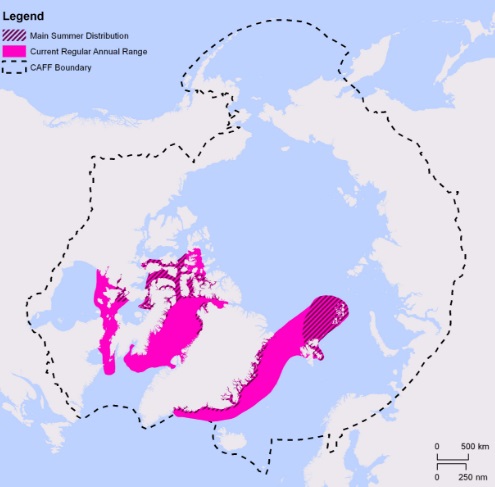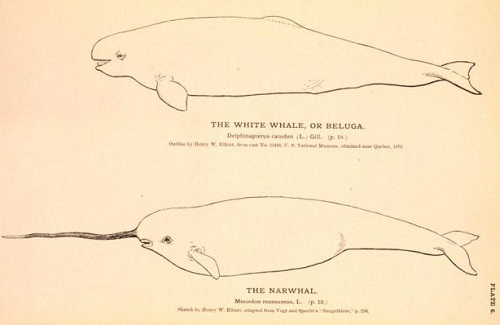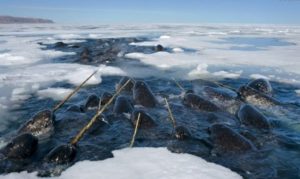Taxonomy
Kingdom |
Phylum |
Class |
Order |
Family |
Genus |
Species |
| Animalia | Chordata | Mammalia | Artiodactyla | Monodontidae | Monodon | Monodon monoceros |
Interesting facts
- During winter sometimes narwhals get trapped under fast forming pack ice. They attempt to keep the breathing hole open with their tusks but die of exhaustion and suffocation unable to breathe.
- Tusks are overgrown teeth. Most narwhals have one tusk while a minority will develop two.
- Narwhals are one of the most vulnerable Arctic animals to climate change due to receeding ice coverage in their habitat in northern grounds.
- There are no narwhals in captivity. In the 60s and 70s there were several attempts at keeping narwhals in captivity but all died within several months.
- Narwhals and belugas are close relatives.
o
o
Name
- Scientific Name: Monodon monoceros, derived from the Greek “one tooth one horn”.
- Common Name: Narwhal, Unicorn whale.
Conservation Status and Population
- For centuries Inuits in Canada and Greenland have hunted narwhals as a source of food and tusk ivory for tools and weapons. Mattak, the blubber attached to the skin, is a delicacy.
- Regulation and quotas in Canada and Greenland are managed regionally.
- Its population has been estimated at 80,000 individuals.
- Sub populations along its range are subject to different levels of threat. Hunting, vessel accidents, disturbance and pollution from the oil and gas industry and global warming represent a constant threat.
- Narwhals are considered a “Near Threatened” species by the IUCN.
- They are listed in Appendix II of Cites and Appendix II of CMS.
Distribution and Habitat
- Narwhals have a narrow geographical distribution, mainly in the Atlantic sector of the Arctic, from the Central Canadian Arctic eastward to Greenland and to the eastern Russian Arctic. They cover the Arctic waters of Canada, Norway, Greenland and Russia.
- In the winter, between November and March, most narwhals, about 70,000 migrate to the Baffin Bay and Davis Strait located between Canada and Greenland where they spend about 6 months. Other groups spend their summer in the bays and fjords along the East Baffin Island, Hudson Bay and West and East Greenland. Migration takes about 2 months.
- Their wintering grounds are the most important habitat for narwhals because that is where intense feeding occurs.
- In the summer they return to the northern grounds where they inhabit the deep offshore waters under pack ice.

Narwhal distribution map adapted from Conservation of Arctic Flora and Fauna (CAFF)
Physical Features
- The narwhal is a marine mammal and like the beluga it is a medium sized whale. Its most distinctive feature is its tusk which grows throughout its life and can reach lengths of 1.5 to 3.1 meters.
- Tusks are formed from the left canine tooth that grows from the upper jaw and through the lip forming a spiral. Some narwhals have two tusks when the right canine also grows through the lip. Tusks are hollow and can weight an average of 22 lb (10 kg).
- Tusks are sensory organs with million of nerve endings. They are used to help locate food and to show male dominance. Native cultures thought that their tusks had magical powers.
- Their bodies, excluding tusk, can reach from 13 to 18 feet (3.95 to 5.5 meters). They weight from 1,800 to 3,500 lbs (800 to 1,600 kg).
- Narwhals do not have dorsal fins but an irregular ridge that extends about 2 to 3 feet (60 to 90 cm) long and 2 inches (5 cm) high. Its pectoral fin reaches 11.8 to 15.8 inches (30 to 40 cm) long and its tail flukes is 3.3 to 4 feet (1 to 1.2 meters) long.
- The skin of an adult narwhal has a mottled grey, white and black pigmentation. Young narwhals have grey skin and develop mottled skin when they turn 2. Old narwhals have white skin.
- Its forehead contains an organ called melon which is a round sensory organ used for echolocation.

Narwhals and belugas are close relatives
Behavior
- Narwhals dive up to nearly 1,500 meters and can last underwater for 25 minutes before they resurface.
- They travel and feed in pods of 2 to 10 individuals but they sometimes congregate in herds of hundreds or even thousands when plenty of food is available.
- They migrate seasonally returning to preferred wintering grounds every year. During winter they migrate south where they inhabit shallow waters near the coast in search of food and in the summer they return north to deep waters covered with pack ice.
- Narwhals use echolocation to navigate and hunt. They produce squeaks, clicks and whistles which bounce back to them in the form of echo and is analyzed by the melon which works as a sound lens.

Narwhals congregate into the hundreds or thousands to migrate south during winter and back north in the summer.
Diet
- Narwhals are specialized predators, they eat Greenland halibut, squid, shrimp and polar and arctic cod.
- They feed heavily during migrations.
Reproduction
- Females reach sexual maturity at 6 to 7 years while males at 9 years old.
- Narwhals mate from March to May. Gestation lasts 15.3 months and calves are born between July and August of the next year.
- A single calf is born and is fully dependent on the mother, it lactates from 12 to 20 months. They swim very close to its mother learning all skills needed for an independent live.
Life Expectancy
- Narwhals can live up to 50 years.
Predators
- Among its predators are killer whales (orcas), polar bears, walruses and humans.
Reference and further research
- Convention on the Conservation of Migratory Species of Wild Animals – monodon monoceros
- IUCN Red List of Threatened Species – Monodon monoceros
- ITIS Report
- The Animal Aging and Longevity Database – Monodon monoceros
- World Register of Marine Species
- Marine Species Identification Portal
- Food and Agriculture Organization of the United Nations Fisheries and Aquaculture Department – monodon monoceros
- Fisheries and Oceans Canada – Advice Regarding the Genetic Structure of Canadian Narwhal
- The Royal Society – Use of glacial fronts by narwhals (monodon monoceros) in Greenland
- CITES – Review of significant trade in the narwhal (monodon monoceros)
